|
|||||||||||||||||||||||||||||||||||
In 1979, a decade had past since the last episode of Star Trek the television show was made. But in that decade through re-run syndication, the studio learned they should have been looking at demographics and not just numbers: Star Trek was more popular than they had ever dreamed, as it became part of pop culture. In 1977, Star Wars dominated the box office, exposing an audience hungry for big screen sci-fi films. In response, the work already begun on a Star Trek Phase II TV series was molded into a major motion picture project. This, the first film then, was of critical importance. While the TV show came first, it is the movie that set in motion the titanic entertainment franchise we know today.
A massive cloud of unknown origin and unbelievable power is on a course to earth. The only federation ship able to reach the threat in time is the newly refitted Enterprise. Captain Kirk pulls some strings to get command of his old home, and together with his crew, they speed off into the unknown. The story, while decent as far as sci-fi screen plays go, is almost ancillary to the statement made in the movie that Star Trek is back, bigger, better, and here to stay. Naturally the original TV cast were called in to assume their roles, and while most willingly oblige, its no secret that Leonard Nimoy was not going to come back to play what is arguably one of the favorite characters. Alternatives were explored, but in the end, he signs on. Like all the main characters, Spock is given a special, dramatic introduction, but no one gets a bigger entrance than the Enterprise itself. Loved by fans, it was presented with barely acceptable special effects on TV. The movie employed a single nine foot long model, which when shot with a special periscope lens, finally gave the ship a sense of size and perspective.
Indeed, the visual effects were among the best and most original of the day. Everything done "the old fashion way", the makers decided to go in a different direction from just a lot of ships exploding (which had been done to death in Star Wars). With talent whose credits included the likes of 2001:A Space Odyssey and Close Encounters, Star Trek: The Motion Picture features some of the most polished visual art of the genre. Composer Jerry Goldsmith intentionally avoids the theme from the TV series, using it only once. His score strikes a good balance with a new anthem and evocative mood setting elements. While Sci-Fi junkies may note that Wise's credits include the classic "The Day the Earth Stood Still", they may miss his more classical achievements including such landmark pictures as "West Side Story" and "The Sound of Music" (shot in the large gauge Todd-AO). His contribution to the picture's substance was enormous. William Shatner's legacy as Kirk has been the target of much humor over the years but in retrospect, under Wise's artful direction, we are presented a human, believable Kirk, trying to overcome something of a mid-life crisis by getting his old command back. Unfortunately, time was not on Wise's side. With a release date looming like the V'ger cloud over him, scenes were cut, effects left out, and the soundtrack short changed. Two decades later, he's finally polished off his picture in DVD format. The Director's Edition
The Directors edition began with an existing interpositive print transferred to Hi-Def on the C-Reality DataCine system by Paramount's Ron Smith and Laura Trumberg. Once the existing picture and sound elements were transferred, the entire production of the Directors Edition was done in the digital domain. What is incredible about the new digital elements is the splice that has been achieved between them and the original footage. By artfully mimicking the characteristics of 1979 optical visual effects, you cannot tell what is old and what is new. Only if you have seen the original cut recently, or are intimately familiar with it, will you be able to pick out what are the new digital elements. They even purposely introduced grain and scratches for a better match with existing material. In addition to the more balanced screen play and the redone visuals, the soundtrack has gotten a welcome update from its original Dolby Stereo mix. With the original sound element stems available, Wise and his team reassembled the soundtrack to the 5.1 layout. Extras Disc two of the set contains a making-of feature on the original film as well as a separate one dealing with the Director's Edition. Both documentaries are insightful and engaging, with a focus on interviews of various personalities and talents related to the franchise. A collection of additional and/or deleted scenes is included as are production notes and story boards. The requisite trailer collection is also there. Disc one serves up a decent commentary track featuring Robert Wise accompanied by talent from the effects department and soundtrack master Jerry Goldsmith. The track is genuinely interesting and offers enough entertainment to make it worth going through. On the whole, an excellent compliment of supplemental material. The Transfer
MPEG Flags The following information only affects progressive scan display of the movie and has no impact on interlaced displays. For an explanation of MPEG Picture Flags, please see the section "How the information is stored on disc" in Part 5 of our DVD Player Benchmark. When we first pulled the picture structure flags from the disc, I thought something was wrong with our software. The entire first chapter was flagged as video, then a few seconds of perfect 3-2 24 fps film cadence, then more video! What we were seeing at this point was the overture (chapter one) and opening credits (in chapter two) following the Paramount logo. While the credits themselves appear to have a 3-2 film cadence, the star field in the background and in the overture appear to be 60 field per second video. Most progressive systems will treat these as the video that they are and sacrifice vertical resolution on the titles. And that was just for starters.
A few of the instances are actually several seconds long, and, depending on your progressive playback setup, could look horrible. We tried this disc on a Sage based system, and the scene of the space port (at 13 m 06 s) combs continuously as shown in this screen shot. Flag reading players just drop to video with the requisite halving of vertical resolution. On the whole, not good at all in the flag department though it seems mostly due to the fact that this edition of the movie was assembled in the video domain without awareness of what happens on progressive scan DVD players. The Audio
Stay tuned for reviews of other Star Trek movies as they are release in special Director's Editions. Next will be Star Trek II: The Wrath of Khan which hits shelves August 6th.
|
|||||||||||||||||||||||||||||||||||


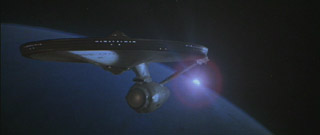 In the beginning
In the beginning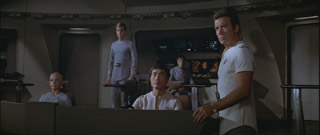 Star
Trek: The Motion Picture
Star
Trek: The Motion Picture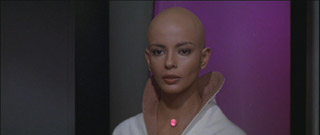 Principal photography on Star Trek: The Motion Picture was shot in 35mm
Panavision with some special effects work being done with large gauge film
(a combination of 65mm and VistsVision).
Principal photography on Star Trek: The Motion Picture was shot in 35mm
Panavision with some special effects work being done with large gauge film
(a combination of 65mm and VistsVision). The concept of a Directors Edition or Cut usually consists mainly of
restoring footage that was trimmed, cut, or shelved due to running length
considerations, censors, or other forces. For Star Trek: The Motion Picture, Robert Wise's vision of
Directors
Edition is pretty much just that. In his message on the DVD's liner jacket, Wise describes
having to cut dialogue to accommodate effects shots and indeed this new
edition has a slightly new and better balance between those key elements.
That didn't stop Wise from taking advantage of the opportunity to redo effects with today's digital technology.
Rather than do a lot of "new" material though, what the restoration team
has done is mostly "redo" existing ones, using the original story boards, giving
Wise the picture he wanted but simply lacked the timetable to produce.
The concept of a Directors Edition or Cut usually consists mainly of
restoring footage that was trimmed, cut, or shelved due to running length
considerations, censors, or other forces. For Star Trek: The Motion Picture, Robert Wise's vision of
Directors
Edition is pretty much just that. In his message on the DVD's liner jacket, Wise describes
having to cut dialogue to accommodate effects shots and indeed this new
edition has a slightly new and better balance between those key elements.
That didn't stop Wise from taking advantage of the opportunity to redo effects with today's digital technology.
Rather than do a lot of "new" material though, what the restoration team
has done is mostly "redo" existing ones, using the original story boards, giving
Wise the picture he wanted but simply lacked the timetable to produce.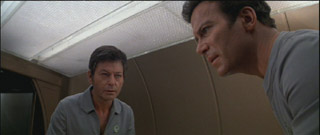 Being
that the print sourced for this new work was an existing interpositive, a
certain amount of graininess is to be expected and as already noted, the
crews doing the new visuals were challenged with matching their work to the less than
perfect condition of the film (the success of which we cannot overstate).
That's not an excuse for poor video, just one factor. We feel the
level of video noise is more than par and at times it is hard to tell the
difference between that and the graininess of the film. On the
positive, the film is very consistent in terms of lighting and color.
Weave and judder are in check, and the shadow detail is excellent (thank
heavens given the abundance of space shots). Highlight detail is adequate, but on
the whole we were somewhat preoccupied with the softness.
Being
that the print sourced for this new work was an existing interpositive, a
certain amount of graininess is to be expected and as already noted, the
crews doing the new visuals were challenged with matching their work to the less than
perfect condition of the film (the success of which we cannot overstate).
That's not an excuse for poor video, just one factor. We feel the
level of video noise is more than par and at times it is hard to tell the
difference between that and the graininess of the film. On the
positive, the film is very consistent in terms of lighting and color.
Weave and judder are in check, and the shadow detail is excellent (thank
heavens given the abundance of space shots). Highlight detail is adequate, but on
the whole we were somewhat preoccupied with the softness. Peppered throughout the movie are instances of the flags
dropping to video. We count 77 in total (that's an average of more
than 1 every 2 minutes). The majority are 4 to 6 fields
long, occurring mostly at scene cuts, suggesting that while the Director's Edition
was assembled in the video domain, many edits and cuts were made without
attention to the film
cadence.
Peppered throughout the movie are instances of the flags
dropping to video. We count 77 in total (that's an average of more
than 1 every 2 minutes). The majority are 4 to 6 fields
long, occurring mostly at scene cuts, suggesting that while the Director's Edition
was assembled in the video domain, many edits and cuts were made without
attention to the film
cadence.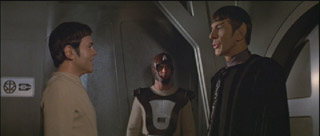 The new 5.1 mix is excellent, all things considered. Fortunately,
the original audio elements were still available for remixing, which means we are getting
a "real" 5.1 soundtrack as opposed to one that had to be synthesized from a
poor two-channel release master. The entire track has a nice crisp top end and a
low end fullness which I don't recall on previous home video releases.
There are a few instances where dialogue is a little rough, giving away the
age of the source material, but intelligibility does not suffer. The
split surrounds are used to full advantage in a judicious manner, so they
enhance but never distract. The occasional "fly-by" effect gives us
the requisite wow factor, but for the most part the surrounds just discreetly
recreate the ambiance of the environments. Music is probably the best
sounding element with clear brass sections and deep, delicious kettle drums.
While there are one or two hard panned dialogue cues, the bulk is properly
centered.
The new 5.1 mix is excellent, all things considered. Fortunately,
the original audio elements were still available for remixing, which means we are getting
a "real" 5.1 soundtrack as opposed to one that had to be synthesized from a
poor two-channel release master. The entire track has a nice crisp top end and a
low end fullness which I don't recall on previous home video releases.
There are a few instances where dialogue is a little rough, giving away the
age of the source material, but intelligibility does not suffer. The
split surrounds are used to full advantage in a judicious manner, so they
enhance but never distract. The occasional "fly-by" effect gives us
the requisite wow factor, but for the most part the surrounds just discreetly
recreate the ambiance of the environments. Music is probably the best
sounding element with clear brass sections and deep, delicious kettle drums.
While there are one or two hard panned dialogue cues, the bulk is properly
centered.

